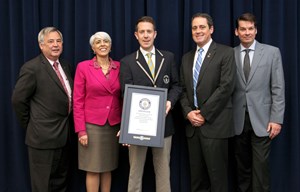Oct 29 2014
Northrop Grumman Corporation, a leader in advanced microelectronics, has developed the world's fastest integrated circuit amplifier, which has been recognized by Guinness World Records.
 Center, Philip Robertson, representative, Guinness World Records, presents the world record certificate for the fastest integrated circuit amplifier to, from left, Dr. Dale Burton, sector vice president and chief technology officer, Northrop Grumman Aerospace Systems; Dr. Arati Prabhakar, director, DARPA; Dr. Dev Palmer, DARPA Terahertz Electronics program manager; and Dr. William Deal, Northrop Grumman Terahertz Electronics program manager.
Center, Philip Robertson, representative, Guinness World Records, presents the world record certificate for the fastest integrated circuit amplifier to, from left, Dr. Dale Burton, sector vice president and chief technology officer, Northrop Grumman Aerospace Systems; Dr. Arati Prabhakar, director, DARPA; Dr. Dev Palmer, DARPA Terahertz Electronics program manager; and Dr. William Deal, Northrop Grumman Terahertz Electronics program manager.
The amplifier uses 10 transistor stages to reach an operating speed of one terahertz (1012 Hz), or one trillion cycles per second—surpassing the company's own performance record of 850 billion cycles per second set in 2012.
Terahertz is a slice of the electromagnetic spectrum that lies between microwaves and infrared light waves. Researchers have long sought to exploit this tremendously high-frequency band, commonly referred to as the "terahertz gap," but have been unable to detect, process and radiate the necessary high-frequency signals without resorting to frequency translation or multiplication.
The Northrop Grumman terahertz monolithic integrated circuit (TMIC) effectively bridges this gap by using a super-scaled 25 nanometer gatelength indium phosphide high electron mobility transistor that measures at a gain of 10 decibels at 1 terahertz and nine decibels at 1.03 terahertz. In comparison, present day smartphones operate at 1 to 2 gigahertz and wireless networks at 5.7 gigahertz.
Developed on behalf of the Defense Advanced Research Projects Agency (DARPA), the circuit is the culmination of the company's three-phase contract with the agency to demonstrate transistor-based electronics operating at 670 gigahertz, 850 gigahertz and 1 terahertz. All three milestones were successfully completed by Northrop Grumman within five years.
"This breakthrough by the Northrop Grumman team could lead to revolutionary technologies such as high-resolution security imaging systems, improved collision-avoidance radar, communications networks with many times the capacity of current systems and spectrometers that could detect potentially dangerous chemicals and explosives with much greater sensitivity," said Dev Palmer, program manager, Microsystems Technology Office at DARPA.
Additional applications could include atmospheric sensing, radio astronomy and medical imaging. It is also expected to improve system range, and reduce size, weight and power consumption of existing systems.
"A decade ago, there was no consensus in the scientific community whether an integrated circuit operating at one terahertz was technologically possible," said William Deal, program manager, terahertz electronics, Northrop Grumman. "An interdisciplinary team of scientists and engineers worked together in scaling all facets of our MMIC technology to enable this result. Now, as a result of DARPA's investment in high-speed transistor processes, it will become routine to fabricate wafers containing thousands of terahertz integrated circuits."
DARPA has made strategic investments in terahertz electronics through its High Frequency Integrated Vacuum Electronics (HiFIVE), Sub-millimeter Wave Imaging Focal Plane Technology (SWIFT) and Technology for Frequency Agile Digitally Synthesized Transmitters (TFAST) programs. Each program built on the successes of the previous one, providing the foundational research necessary for frequencies to reach the terahertz threshold. Northrop Grumman has partnered with DARPA on each program.